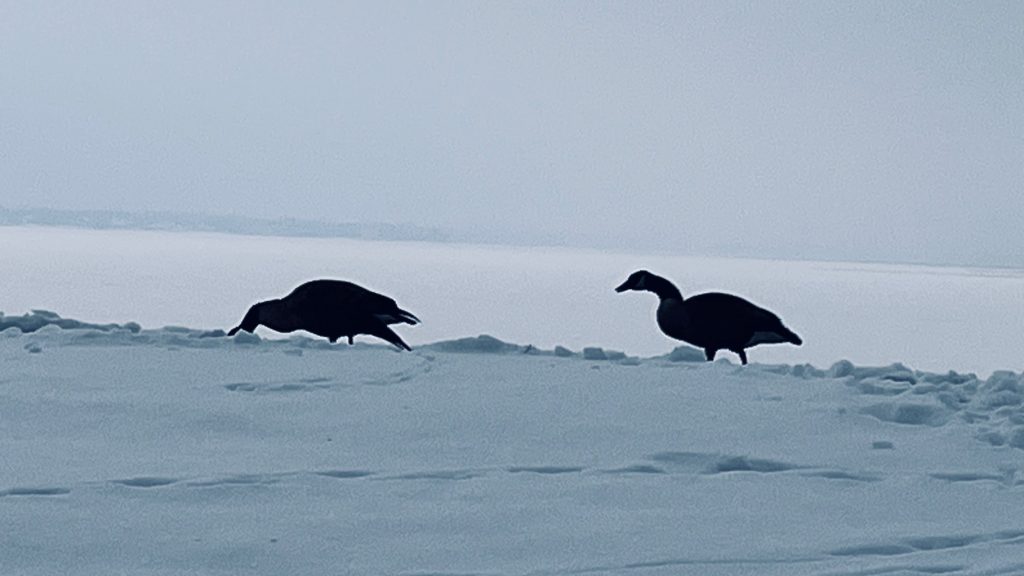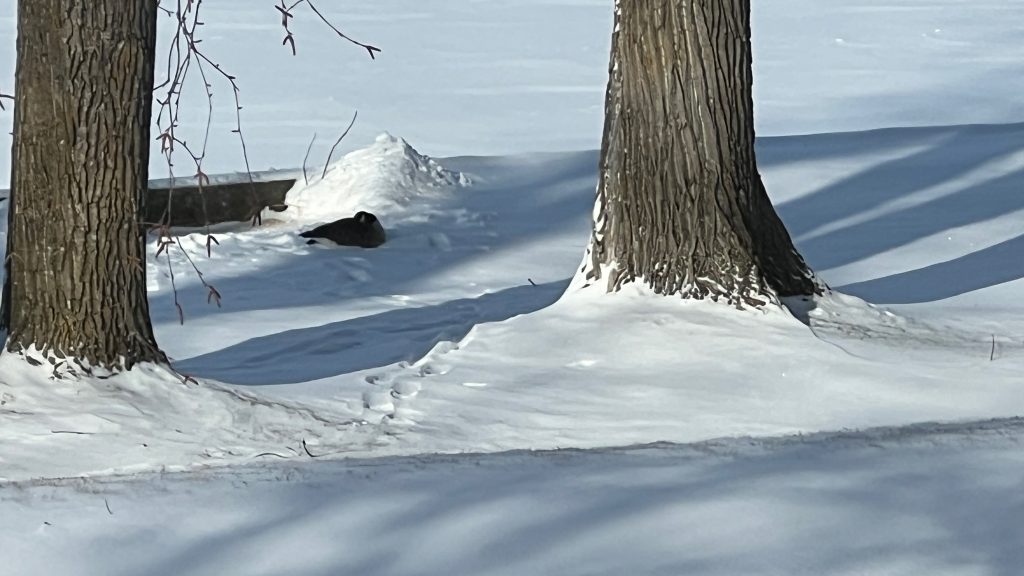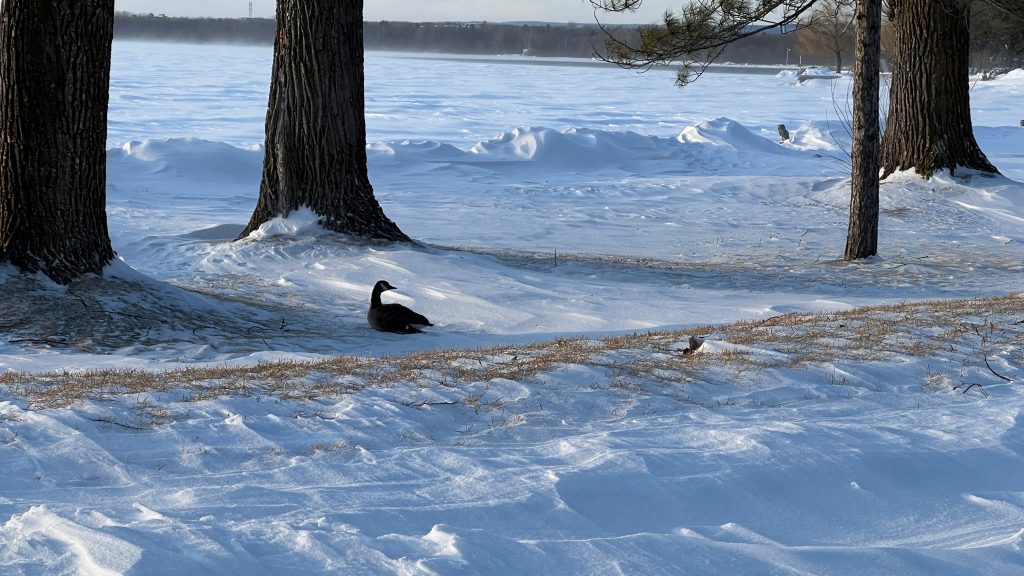The fall weather has inspired me to post this blog as a permanent reminder of, hopefully, a once-in-a-lifetime experience described in a letter I wrote to a Canada goose that overwintered in our backyard on the shore of the Ottawa River near Britannia Beach last winter (2024-25).
This letter came about as a course project. Since 2024 I have been part of an amazing international group of scholars, poets and artists led by Camilla Nelson, founder of Singing Apple Press in the UK. In her course, “Towards an Experimental Ecology of Line,” we discuss and create work in an interdisciplinary, creative-critical environment focused on the exploration of the line in its many different ecological and conceptual forms. In winter 2025 we were dealing with the theme “correspondence” when the idea for a letter to Lonesome Goose came to mind. Correspondence works on a couple of levels. First there is space-time correspondence. Then there is conceptual correspondence of meaning-making. If the goose’s life is one line and mine another, the correspondence marks the place where our lifelines intersect. On a more everyday bases, correspondence commonly refers to communication by letter, email or other messaging.
The remainder of this blog describes how our correspondence came about, along with some photos.
The Goose Situation
On December 22nd, just before Christmas we had noticed a solitary Canada Goose in our backyard. Our property backs on the Ottawa River and with its extensive green space proves to be a very popular resting and grazing stop-over for Canada Geese on their annual migration to southern climes. The next day, the same goose remained, pecking at the frozen grass through a layer of snow. We sensed this could be a problem for a single bird left alone. In general, Canada Geese are gregarious, and injured birds are rarely abandoned. We did not want to interfere with nature but also did not want to watch this animal suffer. We contacted the Ontario Wildlife Rescue organization who redirected us to the Ottawa Valley Wild Bird Care Centre. Unfortunately, they don’t rescue stranded Canada geese but they put us in contact with a local group that did. Within a couple of hours of the initial call, we were talking to a naturalist. She asked us to get some pictures so she could assess the situation. Out back we took a video of the goose – it did not seem to be hurt as it walked away quickly as we approached but could not, or at least did not, fly away. They planned on coming out to assess the situation over the weekend.
The next day we observed a second Canada Goose with the first. She obviously had an injured wing, and we guessed she had been recovering under a large blue spruce while her mate stood guard. In the Christmas cold snap they were in grave danger of starving and freezing in the open. We got back on the phone with the wildlife folks, who told us that two birds meant a rescue would not be feasible and it was possible that they might overwinter here. We were asked if we were willing to feed the birds a healthy mix of bird seed and grain. They could survive the Ottawa temperatures if they could consume enough calories to keep warm.

In the days leading up to and following Christmas, we prepared the meal of rich food to augment the geese’s’ gleanings of frozen grass. We cleared snow and sprinkled the food in their preferred locations. We involved our neighbours who contributed food and agreed to keep pets at bay. One afternoon, we were terrified when a stray cat began stalking the injured goose. To our amazement and relief, both birds flew away! But in a few hours, they were back. This left us wondering why these birds were still in the backyard if they could fly – could our feeding them be keeping them here?
A thaw in the weather brings hope
In the last days of 2024, the weather warmed and the snow melted leaving the lawn bare. This would mean that the pair could access food on their journey south. The mate disappeared first, then the injured one. We were relieved that the birds had made it off on their belated southern journey. But on January 1rst it started to snow. With it, came one goose. Although the injured goose was clearly feeling better, the injured wing was hanging down and probably too weak for the long haul. The partner took advantage of the thaw to make a getaway. So began our daily ritual that would continue throughout the winter months.

Every day I shovelled my path through heavy snows out to the sea wall – a place the lone goose seemed to favour for a while. I made a snow fort to protect the bird against high winds whipping down the Ottawa River. Every morning, I put out seed and grain and shortly afterwards the bird arrived, often spending two or more hours eating her fill. Then she would fly off northwards towards the Deschênes Rapides and open water where she would be safe from predators.

Then things got really bad
As the weather worsened, the fort lost its appeal. The goose opted for the wind-blown grass around three large cottonwoods. So that is where I put the food. Some days the wind was so fierce I had to wear ski goggles out back. Despite this terrible weather, the goose came, ate, and hunkered down. Other animals also enjoyed the food, especially squirrels and crows.

To my horror in early March, Lonesome, under leaden skies, was attacked by three crows but she stood her ground. Then came freezing rain. She disappeared for a few days. It has been a long and lonely winter for this critter. I really hoped she was going to make it. This is when the Letter was written.
Finally, the melt started in early March. Ducks gathered in meltwater pools in the backyard. Lonesome came back. I continued to put out food to everyone’s satisfaction. I eagerly anticipated the arrival of geese, hoping Lonesome’s partner would be an early arrival.
The geese started to arrive. It was so funny when they saw me with food, they all ran towards me. Very different from Lonesome who always kept her distance.
Afterword
Unfortunately this is not a romance novel with the happy ending. We did spot Lonesome a few times on the lawn during the spring, apart in the company of other geese. As they moved off to their breeding grounds, Lonesome departed as well. We always look for that distinctive bent wing. And I hope she has had a good summer and will be able to migrate.
Note on gender
I did not know whether Lonrsome was a male or female. In my daily journal I alternated calling her “her” one day and “him” the next. For this blog post I am using she because I realized she was very small compared with incoming birds – especially the very large raucous males. As an animal advocate, we opt not to call animals “it,” to avoid objectification. I could have avoided this angst by using Robin Wall Kimmerer’s suggested “Ki” as a pronoun to avoid both “it” and human gender biases. Ki is the last syllable of Bemaadiziiaaki, the Anishinaabe word for beings of the living Earth and the first two letters of Kin, signifying that all life is our kin.*
- Robin Wall Kimmerer, Nature Needs a New Pronoun: To Stop the Age of Extinction, Let’s Start by Ditching “It”, Yes! March 30, 2015. https://www.yesmagazine.org/issue/together-earth/2015/03/30/alternative-grammar-a-new-language-of-kinship
